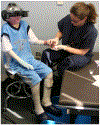Virtual reality hand therapy: A new tool for nonopioid analgesia for acute procedural pain, hand rehabilitation, and VR embodiment therapy for phantom limb pain
- PMID: 32482376
- PMCID: PMC7719341
- DOI: 10.1016/j.jht.2020.04.001
Virtual reality hand therapy: A new tool for nonopioid analgesia for acute procedural pain, hand rehabilitation, and VR embodiment therapy for phantom limb pain
Abstract
Introduction: Affordable virtual reality (VR) technology is now widely available. Billions of dollars are currently being invested into improving and mass producing VR and augmented reality products.
Purpose of the study: The purpose of the present study is to explore the potential of immersive VR to make physical therapy/occupational therapy less painful, more fun, and to help motivate patients to cooperate with their hand therapist.
Discussion: The following topics are covered: a) psychological influences on pain perception, b) the logic of how VR analgesia works, c) evidence for reduction of acute procedural pain during hand therapy, d) recent major advances in VR technology, and e) future directions-immersive VR embodiment therapy for phantom limb (chronic) pain.
Conclusion: VR hand therapy has potential for a wide range of patient populations needing hand therapy, including acute pain and potentially chronic pain patients. Being in VR helps reduce the patients' pain, making it less painful for patients to move their hand/fingers during hand therapy, and gamified VR can help motivate the patient to perform therapeutic hand exercises, and make hand therapy more fun. In addition, VR camera-based hand tracking technology may be used to help therapists monitor how well patients are doing their hand therapy exercises, and to quantify whether adherence to treatment increases long-term functionality. Additional research and development into using VR as a tool for hand therapist is recommended for both acute pain and persistent pain patient populations.
Keywords: Acute pain; Hand therapy; Immersive virtual reality; Pain distraction phantom limb pain; Persistent pain.
Copyright © 2020 Hanley & Belfus. Published by Elsevier Inc. All rights reserved.
Conflict of interest statement
The authors do not have any conflicts of interest. The first author has joined the Scientific Advisory Board of
Although one author works for Johnson and Johnson and one works for GlaxoSmithKline (GSK), no products or funding from these sources were involved in the conduct of any of the studies in the current manuscript, and these are not considered competing interests.
Figures








References
-
- Melzack R, The tragedy of needless pain. Scientific American, 1990;262:27–33. - PubMed
-
- Hoffman HG, Rodriguez RA, Gonzalez M, Bernardy M, Peña R, Beck W, Patterson DR, Meyer III WJ. Immersive virtual reality as an adjunctive non-opioid analgesic for predominantly Latin American children with large severe burn wounds during burn wound cleaning in the Intensive Care Unit: A pilot study. Front. Hum. Neurosci, 2019;13:1–11. DOI: 10.3389/fnhum.2019.00262 - DOI - PMC - PubMed
-
- Pavlova M, Kopala-Sibley DC, Nania C, Mychasiuk R, Christensen J, McPeak A, Tomfohr-Madsen L, Katz J, Palermo TM, Noel M. Sleep disturbance underlies the co-occurrence of trauma and pediatric chronic pain: a longitudinal examination. Pain, 2020;. doi: 10.1097/j.pain.0000000000001769. [Epub ahead of print] - DOI - PubMed
Publication types
MeSH terms
Grants and funding
LinkOut - more resources
Full Text Sources
Medical
Research Materials

